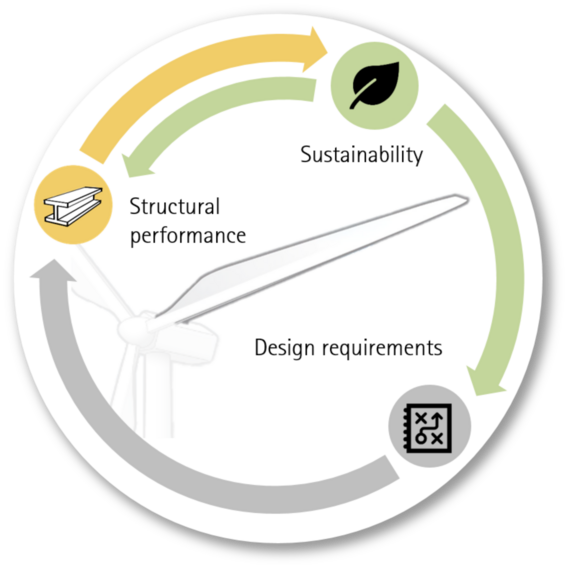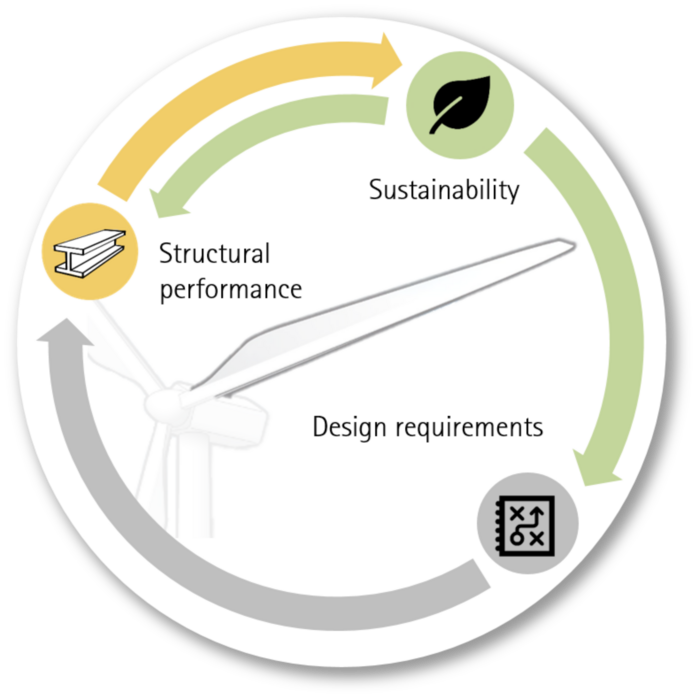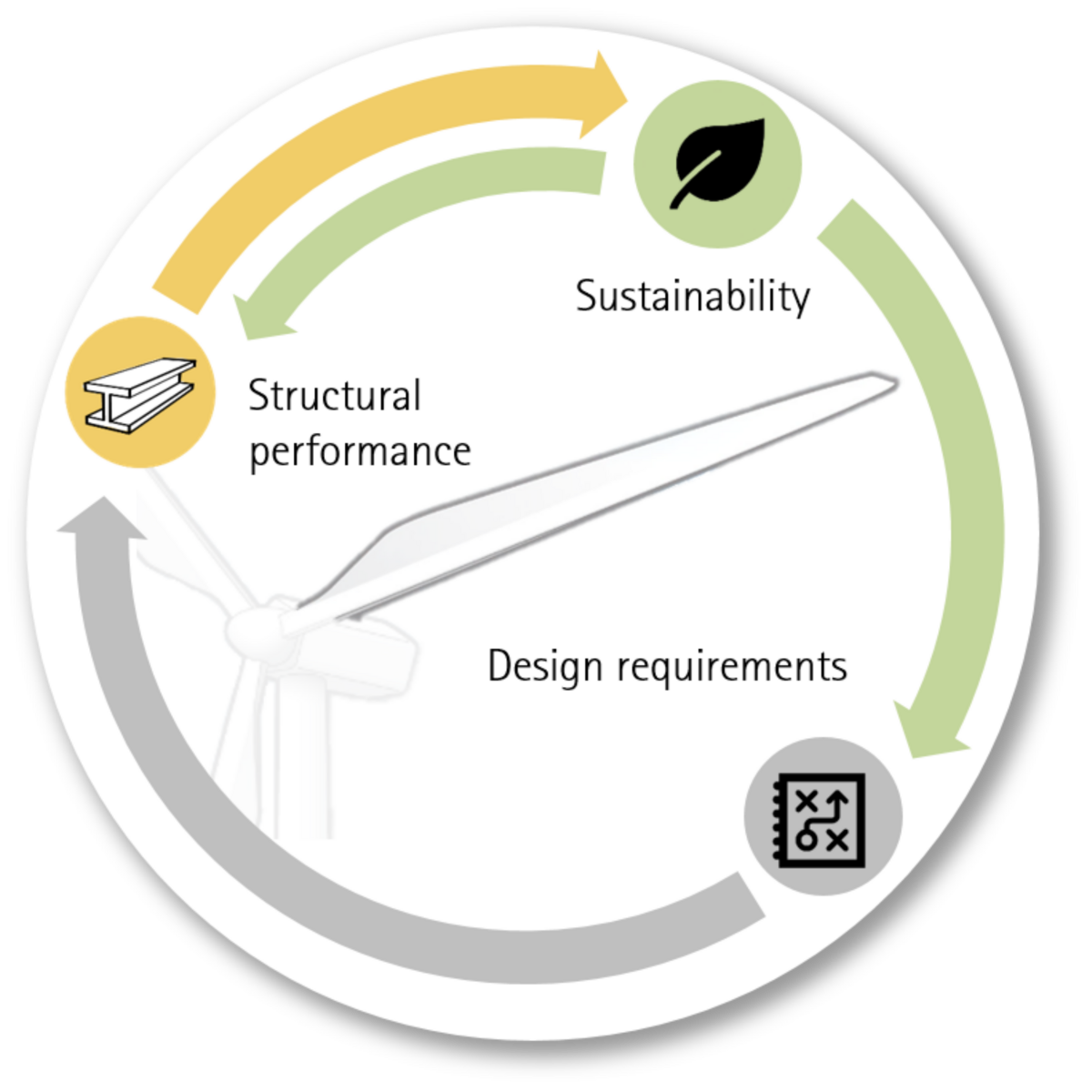Wind turbine rotor blades are large mega-structures typically made of composite materials consisting of artificial fibres and thermosetting resins. The composites and their constituents are energy- and CO2-intensive to produce. The curing reaction of the resin is irreversible, which makes the materials difficult to recycle. Hence, dismantled rotor blades have often been disposed of by landfilling in the past, which is hazardous for the environment and in the meanwhile has become forbidden in most countries. To increase the sustainability of rotor blades, Siemens-Gamesa has recently installed the first recyclable rotor blades, which are based on a dissolvable resin system for fibre recovery. Other manufacturers (OEMs) are trying to catch up and develop their own solutions. However, there is no combined activity in these developments, so that each OEM has its own recyclable materials and corresponding specialised recycling processes. It is challenging for operators and their partner companies to handle the large variety of different materials and recycling processes. Hence, there are doubts that the recyclable blades will really be recycled after their service life. It seems rather more likely that they will be downcycled to lower quality goods, which contradicts the principle of a circular economy. Alternatively, bio-based materials could be used that are bio-degradable, enabling non-hazardous landfilling and the implementation of a mid- to long-term zero waste strategy.
During the last decades, wind energy has become an extremely competitive industry providing a very low cost of energy. To further bring forward the energy transition, it is important to continue to offer cost-effective and reliable products that must offer at least 20-30 years of service life combined with high technical availability. It is thus essential for the design of rotor blade megastructures to have proper design procedures that accurately consider all physical effects that may impact their reliability and availability. These include aero-servo-elastic couplings and the associated vibrations and deformations (e.g., blade tip deflection and cross-sectional deformations), as well as the material behaviour during the entire operation life (e.g., fatigue).
Some of these aspects have been investigated in previous work with the aim of improving cost-effectiveness and reliability. A two-step aero-structurally coupled design process has been developed based on the proper gradient-based formulation of a multi-disciplinary optimisation problem that captures the trade-offs between costs and annual energy production (AEP). This design process was used to develop two 20 MW class turbine models, including the rotor blade designs, in close collaboration with sub-project B02. Cross-sectional deformations (so-called blade breathing), the associated aero-structural coupling, its impact on the mechanical loads that the blade needs to be designed for, and the resulting implications for rotor blade design have also been investigated. However, there is a need to further improve reliability and sustainability of wind turbine rotor blades in order to make wind energy even more cost-effective and environmentally friendly.



To improve the sustainability of wind turbines further, classical fibre composite materials used in rotor blades must be replaced as far as possible by bio-based composites. The lower mechanical performance of bio-based composite materials must be compensated for by innovative composite design concepts that push further towards the limits of material load-bearing capacity, taking into account fatigue to ensure the same level of reliability. Such disruptive technology changes pose significant risks that must be addressed with the use of the digital twin. The idea is to utilise the operational life of the turbine fleet as a massive test programme and enable the verification and validation of blade design assumptions during operation. This operational design verification and validation must be fast and highly accurate and must therefore be based on a high-fidelity digital twin of the rotor blade to capture effects such as blade breathing and its impact on the structural integrity of the blade.
In general, the research objective is to improve the sustainability and reliability of wind turbine rotor blades. The following research questions will be answered in more detail:
- How much of a rotor blade structure can be replaced by bio-based composites? Can innovative and unconventional laminate concepts compensate for the associated reduction in material performance?
- How can sustainability be integrated into the objective function of the multidisciplinary design optimisation procedure to allow a design assessment with respect to sustainability and cost-efficiency, and an analysis of their trade-offs?
- How can operational design verification and validation be realised by co-simulation, coupling a high-fidelity digital twin of the rotor blade with the real twin?
- Can artificial intelligence help to speed up the high-fidelity co-simulation to make the operational design verification and validation strategy feasible and applicable for real offshore wind turbines?
Publications
-
2024: Lightworks, a scientific research framework for the design of stiffened composite-panel structures using gradient-based optimization
Dähne, S.; Werthen, E.; T`Zerbst, D.; Tönjes, L.; Traub, H.; Hühne, C. (2024): Lightworks, a scientific research framework for the design of stiffened composite-panel structures using gradient-based optimization, Structural and Multidisciplinary Optimization
-
2024: Equivalent plate formulation of double-double laminates for the gradient-based design opimization of composite structures
Zerbst, D., Tönjes, L., Dähne, S., Werthen, E., Kappel, E., Hühne, C. (2024): Equivalent plate formulation of Double–Double laminates for the gradient-based design optimization of composite structures, Compos. Struct., 2024
-
2023: Comparison of different cross-sectional approaches for the structural design and optimization of composite wind turbine blades based on beam models
Werthen, E., Hardt, D., Balzani, C., Hühne C. (2023): Comparison of different cross-sectional approaches for the structural design and optimization of composite wind turbine blades based on beam models. Wind Energy Science
-
2023: Aero-structural coupled optimization of a rotor blade for an upscaled 25 MW reference wind turbine
Werthen, E.; Ribnitzky, D.; Zerbst, D.; Kühn, M.; Hühne, C. (2023): Aero-structural coupled optmization of a rotor blade for an upscaled 25 MW reference wind turbine, Journal of Physics: Conference Series 2626, 012012
DOI 10.1088/1742-6596/2626/1/012012
-
2023: Cross-sectional deformation of wind turbine rotor blades
Gebauer, J.; Balzani, C. (2023): Cross-sectional deformation of wind turbine rotor blades, Proceedings of the 33rd International Ocean and Polar Engineering Conference
onepetro.org/ISOPEIOPEC/proceedings-abstract/ISOPE23/All-ISOPE23/ISOPE-I-23-048/524249
-
2023: Impact of shell structure stiffness on aero-structural coupling in wind turbine rotor blades
Balzani, C.; Gebauer, J. (2023): Impact of shell structure stiffness on aero-structural coupling in wind turbine rotor blades, IOP Conference Series: Material Science and Engineering, 1293, 012025
DOI 10.1088/1757-899X/1293/1/012025
-
2023: Aero-structural coupled optimization of a rotor blade for an upscaled 25 MW reference wind turbine
Werthen, E., Ribnitzky, D., Zerbst, D., Kühn, M., Hühne (2023): Aero-structural coupled optimization of a rotor blade for an upscaled 25 MW reference wind turbine, 19th EAWE PhD Seminar, Book of Abstracts, 120-121, Sept. 06-08, 2023, Hanover, Germany
https://phd2023.eawe.eu/site-phd2023/assets/files/programme/BookOfAbstracts.pdf
-
2023: Impact of geometrically non-linear cross-sectional deformations of rotor blades on aerodynamic properties
Gebauer, J., Balzani, C. (2023): Impact of geometrically non-linear cross-sectional deformations of rotor blades on aerodynamic properties, 19th EAWE PhD Seminar, Book of Abstracts, 431-432, September 06-08, 2023, Hanover, Germany
https://phd2023.eawe.eu/site-phd2023/assets/files/programme/BookOfAbstracts.pdf
-
2023: Gradient-based design optimization of composite structures using double-double Laminates
Zerbst, D., Tönjes, L., Ückert, C., Dähne, S., Werthen, E., Kappel, E., Hühne, C. (2023): Gradient-based design optimization of composite structures using double-double laminates, 13th EASN International Conference, Salerno, Italy, 2023
-
2023: A comparison of cross-sectional deformations in a rotor blade for different load distributions
Gebauer, J., Balzani, C. (2023): A comparison of cross-sectional deformations in a rotor blade for different load distributions. Wind Energy Science Conference (WESC), May 23-26, 2023, Glasgow, Scotland, UK
-
2022: Preliminary design of composite wings using beam-based structural models
Zerbst, D., Hecken, T., Balack, P., Freund, S., Werthen, E., Dähne, S., Hühne, C. (2022): Preliminary design of composite wings using beam-based structural models, DLRK 2022, Dresden
-
2022: Description of the methodology for quantifying geometrically non-linear cross-sectional deformations of rotor blades
Gebauer, J., Balzani, C. (2022): Description of the methodology for quantifying geometrically non-linear cross-sectional deformations of rotor blades, 18th EAWE PhD Seminar, Book of Proceedings, 406-407, November 02-04, 2022, Bruges, Belgium
-
2022: Quantification of geometrically non-linear cross-sectional deformations for wind turbine rotor blades
Gebauer, J., Balzani, C. (2022): Quantification of geometrically non-linear cross-sectional deformations for wind turbine rotor blades, 8th European Congress on Computational Methods in Applied Sciences and Engineering (ECCOMAS Congress), June 05-09, 2022, Oslo, Norway
-
2021: Geometrically nonlinear cross-sectional deformations of a very large wind turbine blade
Gebauer, J., Balzani, C., Werthen, E., Hühne, C. (2021): Geometrically nonlinear cross-sectional deformations of a very large wind turbine blade, 17th EAWE PhD Seminar, Book of Proceedings, 196, November 03-05, 2021, Porto, Portugal
https://www.eawe.eu/site/assets/files/downloads/17th-phd-seminar-book-of-abstracts-2021.pdf
Subproject Management
30167 Hannover
Institut für Faserverbundleichtbau und Adaptronik | Funktionsleichtbau
Lilienthalplatz 7
38108 Braunschweig
Institut für Faserverbundleichtbau und Adaptronik | Funktionsleichtbau
Lilienthalplatz 7
38108 Braunschweig
Staff
30167 Hannover
Institut für Faserverbundleichtbau und Adaptronik | Funktionsleichtbau (FA-FLB) | c/o ZAL TechCenter Hein-Saß-Weg 22
21129 Hamburg
Institut für Faserverbundleichtbau und Adaptronik | Funktionsleichtbau (FA-FLB) | c/o ZAL TechCenter Hein-Saß-Weg 22
21129 Hamburg






